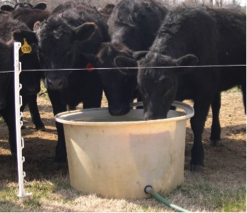Planning Your Grazing System

Rotational grazing can help producers increase forage productivity, which can increase the profitability of an operation. Additional benefits to implementing a rotational grazing system include: reduced supplemental feed costs, improved animal distribution and forage utilization, improved manure distribution and nutrient use, and many more. While many producers want to achieve these benefits, many struggle with implementing a system to achieve their grazing goals. Thoughtfully planning a system that works for your operation is a critical first step toward implementing a successful grazing system.
Know What You Have - The development of any grazing system starts with an inventory of what the operation already has and then developing a plan of how to best use those resources going forward. The best way to start this process is by obtaining aerial maps of the farm from your local NRCS office or using a computer program such as Google Earth. The larger the scale of these maps, the easier it will be to see landscape details. Making several copies of these maps allows one to draw on them and adjust their plan as needed. Another useful map in planning a grazing system is a soils map. When used along with a list of soil descriptions, producers can get an idea of forage yield potential of their farm.
Forage - The next area needing consideration is the forage base of a farm. Producers need to understand when forage is going to be available and identify gaps in forage availability. The typical Kentucky farm is going to have a cool-season forage base consisting of tall fescue, bluegrass, clovers and possibly orchardgrass. Depending on the goals of the operation, the forage base could be further developed to include inter-seeding legumes and establishing warm season perennial grasses or annual forages to fill gaps.

Water - One of the biggest challenges in developing a grazing system is water availability. Wherever animals are grazing, water must be available. Research shows that if water is within 800 feet of cattle, pastures are grazed more uniformly and manure is distributed more evenly over a pasture. When water is farther away than 800 feet, pasture use decreases and overgrazing of areas closer to water occurs. All potential water sources should be considered when developing a grazing system. Ponds, springs, streams, municipal water and wells are options and can all contribute to providing water to livestock. If it is possible to utilize portable water systems, like the one shown in Figure 1, while developing a grazing system, producers can evaluate waterer locations and make better decisions about where to place permanent waterers.
Fencing - Fencing is another big part of any grazing system. Most grazing systems use both permanent and temporary fencing. When looking at farm maps, make sure to draw in boundaries and permanent fences. Once all current fences are drawn, stop to evaluate the current layout’s benefits and deficiencies. Next, subdivide pastures into smaller, more uniformly sized paddocks. Square shaped paddocks use less fence when compared to other shapes like rectangles or triangles. Try different temporary fencing components and decide what works best. Using temporary fences for internal divisions provides flexibility to the system that can be changed and improved. For more information on fencing for grazing systems, see the UK publication Planning Fencing Systems for Intensive Grazing Management.
Animals - Understanding the needs of the animals to be grazed is important in developing a grazing system. Producers must account for livestock’s nutrient requirements and how requirements are affected by species, breed, stage of production, and age of animals, as well as environmental conditions. Producers need to understand if the animals’ requirements will be met with the pasture provided. The importance of providing shade for animals is often overlooked. Cows provided with shade spend more time grazing and less time standing than those without shade. Producers need to evaluate pastures based on available natural shade and determine if artificial shade should be added. The combination of an animals’ changing nutritional needs and changing pasture conditions require greater management on the part of the producer to maximize production.
Time/Labor - One final component to a grazing system is the time or labor associated with managing it. There are operations with highly developed grazing systems, in which animals are moved multiple times each day to fresh pastures. On the other end of the scale are operations that move once every week. The grazing system must work with the schedule of the individual who is actually moving the animals and temporary fence, and managing other components of the system. However, cattle are quickly trained and often moving to a new paddock takes just minutes. If designed correctly, a grazing system can make management easy and efficient.
Developing a grazing system can be intimidating. By understanding and managing what is already available and adding new components to a system, like new watering sites or subdividing pastures with temporary fencing, soon the system will begin to take shape and producers will reap the rewards of their hard work. For more information on developing a grazing system, see the UK publication Rotational Grazing, or contact your Local Extension Agent or NRCS Grazing Specialist to assist you.
Categories:
Spring
Grazing Systems


